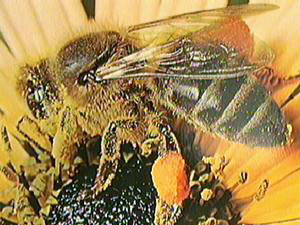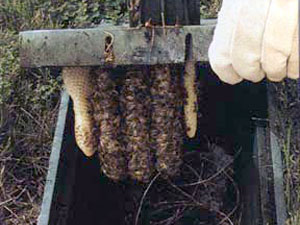
Bee Basics
Africanized Honey Bees look just like the European Honey Bees we've always seen visiting the flowers in our gardens. They function and behave similarly, too, but the Africanized Honey Bee is much more protective of its home.
Just like the European Honey Bee, each Africanized Honey Bee can only sting once and then it dies. Also, the venom in either single sting isn't a problem unless the victim is allergic. The difference is that Africanized Honey Bees are more easily disturbed and respond more quickly, stinging in greater numbers.
Like European Honey Bees, Africanized Honey Bees forage for water, pollen and nectar wherever they can find it and will visit our gardens to do so. They are not likely to attack unless they are disturbed. Left alone, they will pollinate your flowers and then return to their nests without any problems.
Swarming
Both the European Honey Bees and Africanized Honey Bees swarm. This simply means that a colony has become overcrowded and it's time for many of the bees to leave. They take off together in a group, technically a "swarm," in order to establish a new home.
While a large mass of bees, buzzing through the air may seem threatening, it's not interested in attacking anyone; its only purpose is to establish a new home. A swarm will often find a place to rest, in the branch of a tree or other comfortable spot, for a day or two, and then it will usually move on.
If the swarm is left alone, it is not especially dangerous, but do not attempt to move or destroy it yourself and, if possible, stay out of the immediate area. You may need to close your windows and stay inside. If avoiding the area is impossible, you may wish to contact a professional to remove the bees, even before giving them a chance to move on by themselves.
If bees come indoors, turn out the lights so that the bees will be attracted to the windows. If possible, open the window or door closest to them to let them out.

If The Swarm Stays
If the swarm does not move on after 2-3 days, but stays and begins to build a nest, it is best to have it removed or exterminated by a licensed bee removal service or exterminator as soon as possible. The larger the nest, the more difficult it can become to remove and the more it will cost to do so. Also, as their nest grows larger, the bees become more defensive and more likely to attack if they feel threatened.
An existing nest of European Honey Bees can be taken over by Africanized Honey Bees without your knowledge and can suddenly attack with minimal provocation. An existing nest can also attract more bees to the area.
Again, do not attempt to remove any nest of bees yourself; have a professional bee removal company remove it.
Removal
Look for a company that will remove or exterminate bees under "Bee Removal Services" or "Pest Control Services" or contact:
The Structural Pest Control Board
916-263-2540
Department of Pesticide Regulation
916-445-4300
Pest Control Operators of California at
916-372-4363 or www.pcoc.org
for a listing of licensed exterminators in San Diego County
Ensure that the responding person is a state licensed pest control professional, bonded and insured and trained in honey bee removal.
Preventing Nests On Your Property
Africanized Honey Bees are less selective about their nesting sites and are more likely to move into unexpected places, often close to or in the ground. Be aware of potential sites in your yard and do what you can to reduce their appeal to swarming bees:
- Clay pots - Stack clay pots upright, rather than inverting them and creating a welcome home complete with drainage hole door.
- Water meters - Be aware that these sites also feature doors and voids.
- Inside walls - Honey bees can enter a hole ¼ inch in diameter. Patch holes in stucco, install metal screen across vents, and seal the area where faucets and pipes come through the wall.
- Discards - Remove old washing machines, tires, boxes, and other debris
- Sheds and playhouses- If rarely used, inspect cautiously as you enter for the first time, especially if children plan to play there.
Additional Information

Disturbing an established nest of bees can result in a serious stinging incident. If you attempt to remove a swarm or hive by yourself, you risk injury to yourself, your family, and, possibly, your neighbors.
Ignoring a nest on your property can also be dangerous and pose a liability. Keeping bees is against the law within the City of Escondido.
As always, the Escondido Fire Department responds to life-threatening emergencies and will respond immediately if a victim of a bee stinging incident requires rescue and medical care. We do not, however, have the resources to remove swarms or hives; a licensed exterminator should be called if needed.